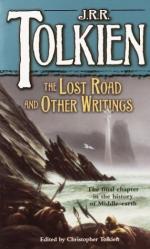|
This section contains 518 words (approx. 2 pages at 400 words per page) |

|
The Lost Road and Other Writings: Language and Legend Before 'the Lord of... Summary & Study Guide Description
The Lost Road and Other Writings: Language and Legend Before 'the Lord of... Summary & Study Guide includes comprehensive information and analysis to help you understand the book. This study guide contains the following sections:
This detailed literature summary also contains Topics for Discussion and a Free Quiz on The Lost Road and Other Writings: Language and Legend Before 'the Lord of... by J. R. R. Tolkien.
The Lost Road and Other Writings is the fifth of the twelve volume series, History of Middle-Earth, published in 1987 by Christopher Tolkien. It consists of unpublished writings by his father, the famous novelist and philologist, J.R.R. Tolkien. It is comprised of an early copy of the Silmarillion stories written between late 1937 and late 1938. At this time, the elder Tolkien put the writings aside to focus on The Lord of the Rings, only to return to the Silmarillion much later. The book is covered in comments by Christopher Tolkien on the nature of the manuscripts, including information about differences between manuscripts and biographical information of interest.
The Lost Road and Other Writings is composed of four parts, which run as follows: Part One: The Fall of Numenor and the Lost Road contains the texts "The Downfall of Numenor" and "The Lost Road". Both of these texts discuss the mythology of Numenor, a large island in the Sundering Seas to the west of Middle-earth that contained the greatest kingdom of Men. However, this great kingdom rebelled against Iluvatar and the Valar, which led to its destruction, along with most of its inhabitants. The two documents attempt to tie Numenorean mythology to that of Middle-Earth and Valinor as a whole. "The Fall of Numenor" is brief and ties Tolkien's interest in the Atlantis myths to this "Second Age" of Middle-Earth.
"The Lost Road", however, is a much more famous document because it was written due to a conversation with C.S. Lewis. Tolkien and Lewis agreed that Lewis should write a book on space travel and Tolkien on time travel. Lewis's book became his famed space trilogy, whereas Tolkien's work became "The Lost Road", which tries to place the Fall of Numenor within the annals of the history of Europe and treats the tale as a time-travel story. Following a few introductory chapters, the narrative peters out.
Part Two: Valinor and Middle-Earth Before The Lord of the Rings contains the final pre-Lord of the Rings manuscripts and typescripts of the pre-history tales, most of which comprise the published Silmarillion. Part Two delineates the order of these writings, including "The Later Annals of Valinor" which reviews the "Valian Years" and the years of the First Age. The first draft of the "Ainulindale" is in the book, which is Tolkien's reworking of "The Music of the Ainur" written nearly twenty years earlier. This story is the Middle-Earth "Creation Story".
However, by far the largest section of the book is the text and commentaries on the Quenta Silmarillion. This early version of the Silmarillion was sent to publishers in 1937 but was not a proper sequel to The Hobbit. Tolkien set the piece aside for several decades until after The Lord of the Rings was completed.
The Lost Road and Other Writings also contains "The Lhammas", which covers the origin and development of the Elvin languages and Part III contains a huge amount of information on the "Etymologies" of root words in the invented languages. Part IV is a series of appendices, containing genealogies, lists of names and maps.
Read more from the Study Guide
|
This section contains 518 words (approx. 2 pages at 400 words per page) |

|



